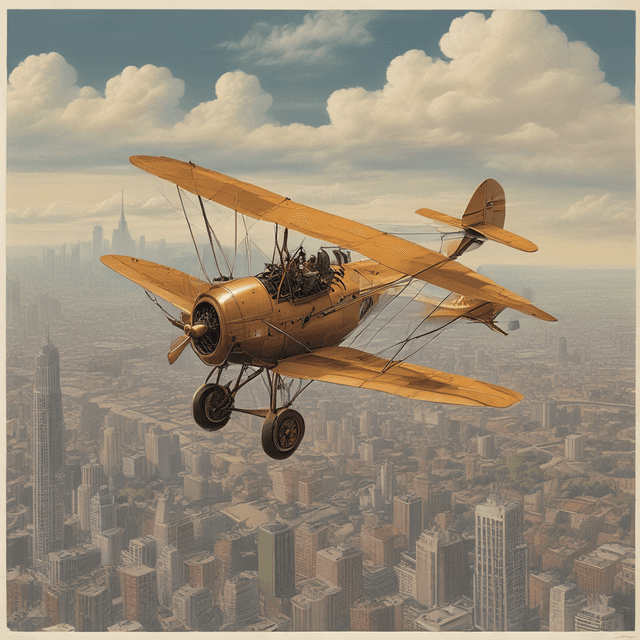
| Field | Aeronautics |
| History | Long and storied, with successful powered flight developing over a century earlier than in our own reality |
| Impacts | Rise of air travel for passengers and cargo • Facilitated global trade, exploration, and colonial expansion |
| Advancements | Aircraft design • Aircraft operation |
| Controversies | Not without criticism |
| Driving forces | Civilian interests • Commercial interests |
Aeronautics, the study and practice of flight, has a rich and influential history in this timeline, with the development of successful powered flight occurring over a century earlier than in our own reality. Driven primarily by civilian and commercial interests rather than military applications, the rapid advancements in aircraft design and operation have transformed global transportation, trade, and exploration since the mid-1800s.
Interest in human flight took off in the 1830s, as scientific breakthroughs in aerodynamics, materials science, and thermodynamics suggested the possibility of powered, heavier-than-air flight. Pioneers like Sir George Cayley in England, Louis-Sébastien Lenormand in France, and Wilhelm Kress in the Austrian Empire began experimenting with gliders, air pressure models, and small steam-powered prototypes.
These early efforts culminated in 1837, when the French inventor Clément Ader conducted the first documented flight of a powered, controlled aircraft over a distance of 160 feet. Ader's "Éole" aircraft was powered by a tiny steam engine and utilized a bat-like wing design. This milestone was followed by further breakthroughs in the 1840s and 1850s, including successful glider flights by Otto Lilienthal in Germany and early experiments with internal combustion engines.
The 1860s and 1870s saw the emergence of several working prototypes of powered, heavier-than-air aircraft capable of sustained, controlled flight. Key innovations included:
In 1873, the French inventor Alphonse Pénaud conducted the first successful flight of a powered, manned aircraft, the "Planophore", which flew for over 100 yards. This was followed by numerous other pioneering flights in the late 1800s, including those of the Wright brothers in the United States and the Voisin brothers in France.
The rapid advancements in aircraft design and propulsion systems in the late 1800s spurred the development of the world's first commercial passenger and cargo airlines. Entrepreneurs in France, Germany, and the Netherlands launched pioneering air transport services in the 1880s, initially focused on mail delivery but soon expanding to human passengers.
The first scheduled commercial passenger flight occurred in 1890, when the French Compagnie Générale Transaérienne began operating a route between Paris and Rouen. By the turn of the century, airlines were springing up across Europe, North America, and the Dutch East Indies, offering intercity and international service. Innovations like pressurized cabins, in-flight meals, and onboard entertainment soon followed.
The rise of commercial air travel in the late 1800s had a transformative impact on global trade, exploration, and colonial expansion. Passenger and cargo aircraft enabled the rapid, long-distance movement of goods, resources, and people in a way that was impossible with 19th-century maritime and rail transport. This facilitated an unprecedented era of globalization, with major impacts on economies, cultures, and political systems worldwide.
European colonial powers like France, the Netherlands, and Germany were particularly quick to leverage air travel to consolidate control over far-flung territories and resources. Air freight became critical for the transport of tropical agricultural products, precious metals, and other raw materials from colonies back to the metropole. Meanwhile, air passenger routes connected remote outposts to the cultural and economic centers of the colonial powers.
The widespread availability of affordable air travel also enabled mass tourism, scientific exploration, and cultural exchange on a global scale for the first time. This contributed to the spread of modern values, technologies, and lifestyles, as well as tensions and backlash from traditional societies.
The transformative impact of aeronautics touched nearly every aspect of modern life in this timeline. The growing ubiquity of air travel fundamentally changed patterns of work, leisure, and social interaction, while also disrupting legacy industries like shipping, railroads, and maritime trade.
Economically, the aviation industry and its related sectors became a major driver of employment, innovation, and GDP growth globally. Aeronautical engineering, manufacturing, and air transportation became vital parts of the economy, with major corporations and financial institutions emerging to support them.
Culturally, air travel profoundly influenced literature, visual arts, music, and fashion. Depictions of flight, aviation, and technological modernity became ubiquitous in popular media, while the experience of air travel itself transformed social rituals, gender roles, and class distinctions. The ability to rapidly traverse vast distances also accelerated the spread of ideas, art, and cultural practices worldwide.
Despite its many transformative benefits, the rise of aeronautics has not been without its critics and challenges. Early pioneers faced skepticism and resistance from traditionalists who feared the social and economic disruption caused by this new technology. There were also significant safety, environmental, and military concerns as aircraft became more sophisticated.
Civil liberties advocates have long debated the surveillance and security implications of air travel, while environmentalists have fought against the greenhouse gas emissions and other ecological impacts of the aviation industry. Accidents, hijackings, and other high-profile incidents have also fueled periodic public backlash and calls for greater regulation.
However, the economic and cultural importance of aeronautics has allowed it to overcome most of these obstacles. As a critical enabler of global trade, travel, and exploration, the industry's influence and political clout have steadily grown, solidifying its central role in the modern world.